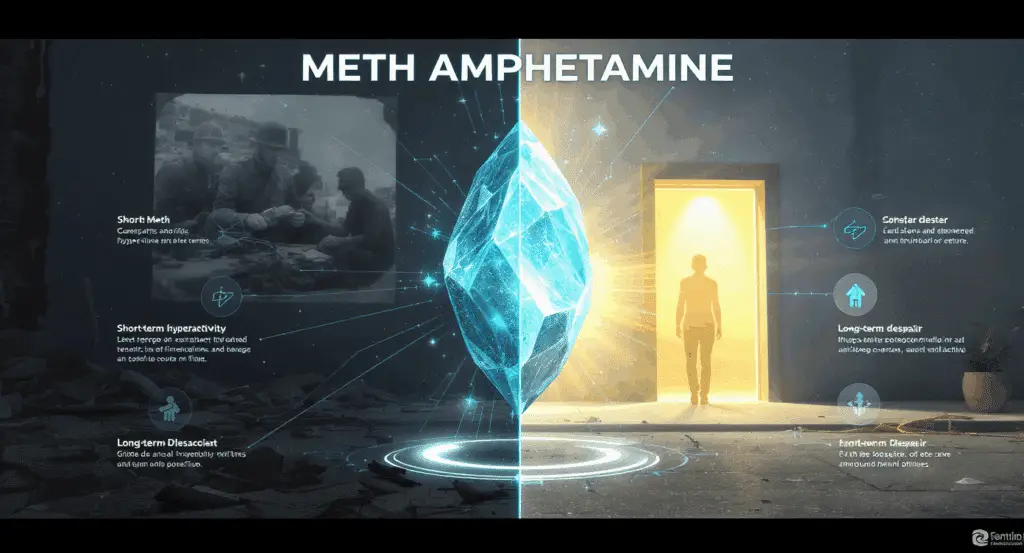KRYSTAL METH
& METAMFETAMIN
HVAD DU HAR BRUG FOR AT VIDE
NARCONON
Komplet uddannelsesressource
Download hele Narconons brochure om crystal meth og metamfetamin for at få omfattende information.
Download komplet PDF-brochureKomplet undervisningsmateriale fra Narconon
Hvad er Crystal Meth?
CRYSTAL METH ER EN FORKORTELSE FOR CRYSTAL METHAMPHETAMINE. Det er en form for stoffet metamfetamin, men stærkere, hårdere, mere vanedannende og mere skadeligt.
Metamfetamin er et hvidt, krystallinsk stof, som folk tager ved at sniffe det, ryge det eller sprøjte det ind med en nål. Nogle tager det endda oralt, men alle udvikler et stærkt ønske om at fortsætte med at bruge det, fordi stoffet skaber en falsk følelse af lykke og velvære - en rus af selvtillid, hyperaktivitet og energi. Folk oplever også nedsat appetit. Virkningerne af stofferne varer generelt seks til otte timer, men kan vare op til fireogtyve timer. Den første oplevelse kan indebære en vis nydelse, men fra starten begynder metamfetamin at ødelægge brugerens liv.
Hvad er metamfetamin?
METAMFETAMIN ER ET ULOVLIGT STOF I SAMME KLASSE SOM KOKAIN OG ANDRE STOFFER PÅ GADEN. Det er et stærkt vanedannende stimulansmiddel, som påvirker centralnervesystemet dramatisk.
Af alle de ulovlige stoffer på markedet har metamfetamin en lidt unik position. Med en forsyning af nogle få basiskemikalier kan en metamfetaminproducent etablere sig hvor som helst. I modsætning til andre stoffer behøver en meth-producent ikke adgang til afgrøder som heroinvalmuer, kokablade eller marihuana, der kun dyrkes i fjerntliggende eller afsidesliggende områder. Han har ikke brug for en samarbejdsvillig apoteker til ulovligt distribueret receptpligtig medicin.
Disse faktorer gør tilsammen metamfetamin til et stof med stort potentiale for udbredt brug. Det har mange kælenavne - meth, crank, chalk eller speed er de mest almindelige. (Se side 13 for en liste over gadenavne).
Som med lignende stimulanser bruges metamfetamin oftest i et binge-and-crash-mønster. Fordi tolerance over for meth opstår inden for få minutter - hvilket betyder, at de behagelige virkninger forsvinder, selv før stofkoncentrationen i blodet falder betydeligt - forsøger brugerne at opretholde rusen ved at drikke for meget af stoffet.
Crystal meth bruges af personer i alle aldre, men det er mest almindeligt som et klubstof, der tages, mens man fester på natklubber eller til ravefester. Dets mest almindelige gadenavne er ice eller glass.
Det er et farligt og potent kemikalie og, som med alle stoffer, en gift, der først virker stimulerende, men derefter begynder at ødelægge kroppen systematisk.
Derfor er det forbundet med alvorlige helbredsproblemer, herunder hukommelsestab, aggression, psykotisk adfærd og potentiel hjerte- og hjerneskade.
Meth er stærkt vanedannende og brænder kroppens naturlige ressourcer af vitaminer og mineraler op, hvilket skaber en ødelæggende afhængighed, som kun kan lindres ved at tage mere af stoffet.
Crystal meths virkning er meget koncentreret, og mange brugere rapporterer, at de bliver afhængige første gang, de bruger det. "Jeg prøvede det én gang, og BOOM! Jeg var afhængig", sagde en methmisbruger, som mistede sin familie, sine venner og sin profession som musiker og endte som hjemløs.
Derfor er det en af de sværeste former for stofmisbrug at behandle.
Hvad er meth lavet af?
METH ER ET SYNTETISK (MENNESKESKABT) KEMIKALIE, I modsætning til f.eks. kokain, som kommer fra en plante.
Meth fremstilles ofte i ulovlige, skjulte laboratorier, hvor man blander forskellige former for amfetamin med andre kemikalier for at øge styrken. Almindelige piller mod forkølelse bruges ofte som grundlag for produktionen af stoffet. Meth-"kokken" udtrækker stoffer fra disse piller og kombinerer ingredienserne med kemikalier som batterisyre, afløbsrens, lygtebrændstof og frostvæske for at øge styrken.
FARLIGE KEMIKALIER
Disse farlige kemikalier er potentielt eksplosive, og fordi meth-kokkene ofte selv er stofbrugere og desorienterede, bliver de ofte alvorligt forbrændte og vansirede eller endda dræbt, når deres præparater eksploderer. Sådanne ulykker bringer andre i nærliggende hjem eller bygninger i fare.
Hver person, der bruger stoffet, udsættes ikke kun for selve det skrappe stimulerende middel, men også for spor og rester af de ætsende og giftige kemikalier, der blev brugt til at fremstille det. De sundhedsmæssige virkninger af disse kemikalier på krop og sind er brutale.
Hvordan ser metamfetamin ud?
Metamfetamin kommer normalt i form af et krystallinsk hvidt pulver, der er lugtfrit og har en bitter smag, og som let opløses i vand eller alkohol.
Andre farver på pulveret er brun, gulgrå, orange og endda pink. Det kan også komprimeres til pilleform. Som tidligere nævnt kan det sniffes, ryges eller injiceres.
Crystal meth kommer i klare, klumpede krystaller, der ligner is, og bliver oftest røget.
De dødelige virkninger af metamfetamin
NÅR DE TAGES, SKABER METH OG CRYSTAL METH EN FALSK FØLELSE AF VELVÆRE OG ENERGI og derfor vil en person have en tendens til at presse sin krop hurtigere og længere, end den er beregnet til. Derfor kan stofbrugere opleve et alvorligt crash eller fysisk og mentalt sammenbrud, når stoffets virkning aftager.
Fordi fortsat brug af stoffet mindsker den naturlige sultfølelse, kan brugerne opleve et ekstremt vægttab. Negative effekter kan også omfatte forstyrrede søvnmønstre, hyperaktivitet, kvalme, øget aggressivitet, vrangforestillinger om magt og irritabilitet.
Andre alvorlige virkninger kan være søvnløshed, forvirring, hallucinationer, angst og paranoia.
I nogle tilfælde kan brug forårsage kramper, der fører til døden.
På lang sigt kan brug af meth forårsage uoprettelige skader: øget hjertefrekvens og blodtryk; beskadigede blodkar i hjernen, der kan forårsage slagtilfælde; en uregelmæssig hjerterytme, der igen kan forårsage kardiovaskulær kollaps eller død; og lever-, nyre- og lungeskader.
Brugere kan få hjerneskader, herunder hukommelsestab og en stigende manglende evne til at forstå abstrakte tanker. De, der kommer sig, har som regel huller i hukommelsen og ekstreme humørsvingninger.
Udtalelse: Melanie
Kontanthjælpen var ikke nok til at betale for vores meth-afhængighed og forsørge vores søn, så vi forvandlede vores lejede hjem til et meth-laboratorium. Vi opbevarede de giftige kemikalier i vores køleskab uden at vide, at giftstofferne ville trænge ind i de andre madvarer i køleboksen. Da jeg gav min treårige søn noget ost at spise, vidste jeg ikke, at jeg gav ham forgiftet mad. Jeg var for skæv af meth til at opdage, at min søn var dødeligt syg, før der var gået tolv timer. Så var jeg så skæv, at det tog mig to timer at finde ud af, hvordan jeg skulle få ham på hospitalet otte kilometer væk. Da jeg nåede frem til skadestuen, blev min dreng erklæret død af en dødelig dosis ammoniakhydroxid - et af de kemikalier, der bruges til at lave meth.
-Melanie
Effekter af crystal meth
Effekter på kort sigt
- Tab af appetit
- Øget hjertefrekvens, blodtryk og kropstemperatur
- Udvidelse af pupiller
- Forstyrrede søvnmønstre
- Kvalme
- Panik og psykose
- Bizar, uberegnelig og til tider voldelig adfærd
- Hallucinationer, hyperexcitabilitet, irritabilitet
- Konvulsioner, anfald og død ved høje doser
Effekter på lang sigt
- Permanent skade på blodkar i hjerte og hjerne
- Højt blodtryk fører til hjerteanfald, slagtilfælde og død
- Lever-, nyre- og lungeskader
- Ødelæggelse af væv i næsen ved indsnusning
- Problemer med luftvejene (vejrtrækning), hvis der ryges
- Infektionssygdomme og bylder ved indsprøjtning
- Underernæring, vægttab
- Alvorligt huller i tænderne
- Psykose
- Desorientering, apati, forvirret udmattelse
- Stærk psykologisk afhængighed
- Depression
- Skader på hjernen svarende til Alzheimers sygdom, slagtilfælde og epilepsi
Gadenavne
METH
KRYSTAL METH
Medicinske komplikationer
METH KAN FORÅRSAGE EN RÆKKE KARDIOVASKULÆRE PROBLEMER (HJERTE OG BLODKAR). Disse omfatter hurtig puls, uregelmæssig hjerterytme, forhøjet blodtryk og irreversibel, slagtilfældeproducerende skade på små blodkar i hjernen. Hypertermi (forhøjet kropstemperatur) og kramper forekommer ved meth-overdoser, og hvis de ikke behandles med det samme, kan de resultere i døden.
Kronisk brug af meth kan resultere i betændelse i hjerteslimhinden og, for brugere, der injicerer stoffet, beskadigede blodkar og hudabscesser. Meth-brugere kan også få episoder med voldelig adfærd, paranoia, angst, forvirring og søvnløshed. Heavy users udviser også progressiv social og erhvervsmæssig forringelse. Psykotiske symptomer kan undertiden vare ved i måneder eller år, efter at brugen er ophørt.
Akut blyforgiftning er en anden potentiel risiko. En almindelig metode til ulovlig meth-produktion bruger en form for bly. Produktionsfejl kan derfor resultere i meth, der er forurenet med bly, så meth-brugere kan lide af akut blyforgiftning.
Forskning viser også, at brug af metamfetamin under graviditeten kan resultere i komplikationer for det ufødte barn, øget forekomst af for tidlig fødsel og ændrede adfærdsmønstre, såsom unormale reflekser og ekstrem irritabilitet. Det kan også være forbundet med misdannelser ved fødslen.
Nedadgående spiral af meth-brug
NÅR FOLK TAGER METH, OVERTAGER DET DERES LIV I VARIERENDE GRAD. Der er tre kategorier af brug:
Lav-intensivt meth-brug
Lavintensive brugere sluger eller sniffer meth. De vil have den ekstra stimulering, som meth giver, så de kan holde sig vågne længe nok til at afslutte en opgave eller et job. Eller de vil have den appetitnedsættende effekt for at tabe sig. De er et skridt fra at blive binge-brugere.
Overdreven brug af meth
Binge-brugere ryger eller injicerer meth med en nål. Det giver dem mulighed for at få en mere intens dosis af stoffet og få en stærkere reaktion, som er psykologisk vanedannende. De er på nippet til at bevæge sig over i et højintensivt forbrug.
Højintensiv brug af meth
De højintensive brugere er narkomanerne, ofte kaldet speedfreaks. Hele deres eksistens fokuserer på at forhindre nedturen, den smertefulde nedtur efter rusen. For at opnå den ønskede rus af stoffet må de tage mere og mere af det. Men som med andre stoffer er hver meth-kick mindre end den foregående, og det driver meth-misbrugeren ind i den mørke og dødbringende afhængighedsspiral.
Stadierne i meth-"oplevelsen"
THE RUSH
Et rush er den første reaktion, som brugeren føler, når han ryger eller injicerer meth. Under rusen slår hjertet hurtigere, og blodtrykket og pulsen stiger. I modsætning til det rush, der er forbundet med crack-kokain, som varer i cirka to til fem minutter, kan meth-rushet fortsætte i op til tredive minutter.
DEN HØJE
Rusen efterfølges af en rus, også kaldet skulderen. Under rusen føler brugeren sig ofte aggressivt klogere og bliver argumenterende, afbryder ofte andre mennesker og afslutter deres sætninger. Vrangforestillingerne kan resultere i, at brugeren bliver intenst fokuseret på en ubetydelig ting, som f.eks. at pudse det samme vindue gentagne gange i flere timer. Rusen kan vare i fire til seksten timer.
BINGE
En binge er ukontrolleret brug af et stof eller alkohol. Det refererer til brugerens trang til at opretholde rusen ved at ryge eller injicere mere meth. Binge kan vare tre til femten dage. Under rusen bliver personen hyperaktiv, både mentalt og fysisk. Hver gang han ryger eller injicerer mere af stoffet, oplever han et nyt, men mindre sus, indtil der til sidst ikke er noget sus og ingen rus.
TWEAKING
En meth-bruger er mest farlig, når han oplever en fase af afhængigheden, der kaldes tweaking - en tilstand, der nås i slutningen af et stofmisbrug, når meth ikke længere giver et sus eller en rus. Tweakeren er ude af stand til at lindre de forfærdelige følelser af tomhed og trang og mister sin identitetsfølelse. Intens kløe er almindelig, og en bruger kan blive overbevist om, at der kravler insekter under hans hud. Personen kan ikke sove i dagevis og befinder sig ofte i en fuldstændig psykotisk tilstand og eksisterer i sin egen verden, hvor han ser og hører ting, som ingen andre kan opfatte. Hallucinationerne er så livagtige, at de virker virkelige, og afkoblet fra virkeligheden kan han blive fjendtlig og farlig for sig selv og andre. Risikoen for at gøre skade på sig selv er stor.
KRASJET
For en binge-bruger sker nedbruddet, når kroppen lukker ned og ikke er i stand til at klare de overvældende stofvirkninger. Det resulterer i en lang periode med søvn for personen. Selv den ondeste, mest voldelige bruger bliver næsten livløs under crashet. Crashet kan vare en til tre dage.
METH HANGOVER
Efter nedbruddet vender brugeren tilbage i en forringet tilstand - udsultet, dehydreret og fuldstændig udmattet, både fysisk, mentalt og følelsesmæssigt. Denne fase varer normalt fra to til fjorten dage. Dette fører til tvungen afhængighed, da "løsningen" på disse følelser er at tage mere meth.
TILBAGETRÆKNING
Først bliver brugeren deprimeret, mister sin energi og evnen til at opleve glæde. Så kommer trangen til mere meth, og personen bliver ofte selvmordstruet. Da meth-abstinenser er ekstremt smertefulde og vanskelige, vender de fleste brugere tilbage. Således vender 93 procent af dem, der er i traditionel behandling, tilbage til at bruge meth.
Livstruende vrangforestillinger
BYER I HELE USA RAPPORTERER OM ØGET PROCENTDEL AF VOLDSEPISODER I HJEMMET forbundet med meth-brug. Husspektakler, der normalt betragtes som farlige situationer for ordensmagten, bliver intensiveret, når en tweaker er involveret, på grund af personens uforudsigelighed.
Mange overtrædelser og ulykker med motorkøretøjer kan også involvere tweakere. Paranoide og hallucinerende tweakere kan beslutte sig for at køre i deres biler. I deres vrangforestillinger virker bevægelige former og skygger truende, og de vil sandsynligvis øge deres hastighed og udvise uberegnelige køremønstre i deres forsøg på at undgå billederne. En yderligere trussel mod samfundet og dem selv kan stamme fra tweakerens tendens til at bevæbne sig af hensyn til deres personlige sikkerhed. Interviews med metamfetaminbrugere har bekræftet, at disse personer ofte har våben i deres biler såvel som i deres hjem.
Tweakers kan også være til stede ved raves eller fester. For at støtte deres vane deltager de ofte i spontane forbrydelser, såsom tasketyverier, røverier med stærk arm, overfald med våben, indbrud og tyveri af motorkøretøjer.
Meth er let tilgængeligt, og nutidens brugere krydser de etniske og kønsmæssige grænser. Meth er psykologisk vanedannende i forbindelse med overstadige og højintensive forbrugsmønstre, hvor brugerne bliver paranoide og uforudsigelige.
Metamfetamin: En kort historie
Hvad er stoffer?
MEDICIN ER I BUND OG GRUND GIFT. Mængden, der tages, bestemmer effekten.
Lille beløb
Fungerer som en stimulerende middel (gør dig hurtigere)
Større beløb
Fungerer som en Beroligende middel (gør dig langsommere)
Endnu større beløb
Giftstoffer og kan slå ihjel
Det gælder for alle stoffer. Kun den mængde, der skal til for at opnå effekten, er forskellig.
Men mange stoffer har et andet ansvar: De påvirker sindet direkte. De kan forvrænge brugerens opfattelse af, hvad der sker omkring ham. Som følge heraf kan personens handlinger være mærkelige, irrationelle, upassende og endda destruktive.
Narkotika blokerer også for alle fornemmelser, både de ønskelige og de uønskede. Så selv om de giver kortvarig lindring af smerter, udvisker de også evnen og årvågenheden og forplumrer en persons tankegang.
Om lægemidler
Medicin er stoffer, der har til formål at få din krop til at fungere bedre ved at fremskynde, bremse eller ændre noget ved den måde, kroppen fungerer på. Nogle gange er de nødvendige. Men medicin er stadig stoffer: De virker som stimulerende eller beroligende midler, og for meget kan slå dig ihjel. Hvis medicin misbruges, kan det være lige så farligt som ulovlige stoffer.
Om Narconon
NARCONON (BETYDER "INGEN NARKOTISKE STOFFER") stof- og alkoholrehabiliteringsprogrammet er åbent for alle, der ønsker at komme ud af deres afhængighed og leve et produktivt, stoffrit liv.
Narconon-programmet tager sig ikke kun af de invaliderende virkninger af stofmisbrug på krop og sind, men hjælper også med at finde ud af, hvorfor en person overhovedet begyndte at tage stoffer. Resultatet er, at titusinder har afsluttet Narconon-programmet og fået et nyt liv uden brug af stoffer.
Ud over rehabilitering af stofmisbrugere har Narconons stofforebyggelsesmedarbejdere uddannet millioner af skolebørn. Narconon har mere end 50 års erfaring med uddannelse om stoffer og har vist sig at være effektiv til at holde unge væk fra stoffer.
Ordliste med begreber
Komplet uddannelsesressource
Download hele Narconons brochure om crystal meth og metamfetamin for at få omfattende information.
Download komplet PDF-brochureKomplet undervisningsmateriale fra Narconon
Find flere lærerige artikler om crystal-meth
Sådan gør du: Forståelse af metamfetamin
Langtidsvirkninger af meth-brug
Hvordan meth ændrer dit liv
Hvorfor crystal meth ødelægger mere end din krop
✅ Sektion FAQ : Uddannelse i Crystal Meth - almindelige spørgsmål
Hvad er crystal meth lavet af?
Crystal meth er et syntetisk stimulerende middel, der ofte fremstilles i ulovlige laboratorier ved hjælp af giftige stoffer som ammoniak, lithium og pseudoefedrin. Disse ingredienser kan forårsage alvorlig skade på brugere og alle, der er involveret i produktionen.
Hvordan påvirker crystal meth hjernen?
Det overstimulerer hjernens belønningssystem og skaber en intens, men kortvarig eufori. Over tid fører det til alvorlige skader, herunder hukommelsestab, aggression og følelsesmæssig ustabilitet.
Er det muligt at komme sig over crystal meth-afhængighed uden medicin?
Ja, det er det. Stoffri rehabiliteringsprogrammer som Narconon fokuserer på afvænning og livsfærdigheder for at hjælpe folk med at genvinde kontrollen uden at være afhængige af substitutionsstoffer.
Hvorfor anses crystal meth for at være et af de mest destruktive stoffer?
Fordi det forårsager hurtig fysisk og mental forringelse, skader centralnervesystemet og skaber et stort potentiale for vold, hallucinationer og langvarig psykose.




